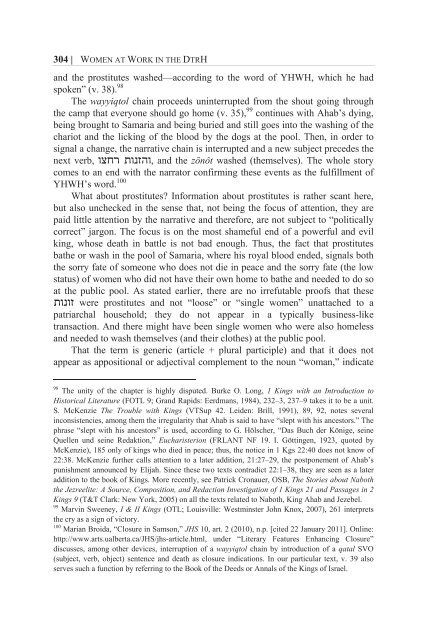Women at Work in the Deuteronomistic History - International Voices ...
Women at Work in the Deuteronomistic History - International Voices ...
Women at Work in the Deuteronomistic History - International Voices ...
Create successful ePaper yourself
Turn your PDF publications into a flip-book with our unique Google optimized e-Paper software.
304 | WOMEN AT WORK IN THE DTRH<br />
and <strong>the</strong> prostitutes washed—accord<strong>in</strong>g to <strong>the</strong> word of YHWH, which he had<br />
spoken” (v. 38). 98<br />
The wayyiqtol cha<strong>in</strong> proceeds un<strong>in</strong>terrupted from <strong>the</strong> shout go<strong>in</strong>g through<br />
<strong>the</strong> camp th<strong>at</strong> everyone should go home (v. 35), 99 cont<strong>in</strong>ues with Ahab’s dy<strong>in</strong>g,<br />
be<strong>in</strong>g brought to Samaria and be<strong>in</strong>g buried and still goes <strong>in</strong>to <strong>the</strong> wash<strong>in</strong>g of <strong>the</strong><br />
chariot and <strong>the</strong> lick<strong>in</strong>g of <strong>the</strong> blood by <strong>the</strong> dogs <strong>at</strong> <strong>the</strong> pool. Then, <strong>in</strong> order to<br />
signal a change, <strong>the</strong> narr<strong>at</strong>ive cha<strong>in</strong> is <strong>in</strong>terrupted and a new subject precedes <strong>the</strong><br />
next verb, וצחר תונזהו, and <strong>the</strong> zōnôt washed (<strong>the</strong>mselves). The whole story<br />
comes to an end with <strong>the</strong> narr<strong>at</strong>or confirm<strong>in</strong>g <strong>the</strong>se events as <strong>the</strong> fulfillment of<br />
YHWH’s word. 100<br />
Wh<strong>at</strong> about prostitutes? Inform<strong>at</strong>ion about prostitutes is r<strong>at</strong>her scant here,<br />
but also unchecked <strong>in</strong> <strong>the</strong> sense th<strong>at</strong>, not be<strong>in</strong>g <strong>the</strong> focus of <strong>at</strong>tention, <strong>the</strong>y are<br />
paid little <strong>at</strong>tention by <strong>the</strong> narr<strong>at</strong>ive and <strong>the</strong>refore, are not subject to “politically<br />
correct” jargon. The focus is on <strong>the</strong> most shameful end of a powerful and evil<br />
k<strong>in</strong>g, whose de<strong>at</strong>h <strong>in</strong> b<strong>at</strong>tle is not bad enough. Thus, <strong>the</strong> fact th<strong>at</strong> prostitutes<br />
b<strong>at</strong>he or wash <strong>in</strong> <strong>the</strong> pool of Samaria, where his royal blood ended, signals both<br />
<strong>the</strong> sorry f<strong>at</strong>e of someone who does not die <strong>in</strong> peace and <strong>the</strong> sorry f<strong>at</strong>e (<strong>the</strong> low<br />
st<strong>at</strong>us) of women who did not have <strong>the</strong>ir own home to b<strong>at</strong>he and needed to do so<br />
<strong>at</strong> <strong>the</strong> public pool. As st<strong>at</strong>ed earlier, <strong>the</strong>re are no irrefutable proofs th<strong>at</strong> <strong>the</strong>se<br />
תונוז were prostitutes and not “loose” or “s<strong>in</strong>gle women” un<strong>at</strong>tached to a<br />
p<strong>at</strong>riarchal household; <strong>the</strong>y do not appear <strong>in</strong> a typically bus<strong>in</strong>ess-like<br />
transaction. And <strong>the</strong>re might have been s<strong>in</strong>gle women who were also homeless<br />
and needed to wash <strong>the</strong>mselves (and <strong>the</strong>ir clo<strong>the</strong>s) <strong>at</strong> <strong>the</strong> public pool.<br />
Th<strong>at</strong> <strong>the</strong> term is generic (article + plural participle) and th<strong>at</strong> it does not<br />
appear as appositional or adjectival complement to <strong>the</strong> noun “woman,” <strong>in</strong>dic<strong>at</strong>e<br />
98<br />
The unity of <strong>the</strong> chapter is highly disputed. Burke O. Long, 1 K<strong>in</strong>gs with an Introduction to<br />
Historical Liter<strong>at</strong>ure (FOTL 9; Grand Rapids: Eerdmans, 1984), 232–3, 237–9 takes it to be a unit.<br />
S. McKenzie The Trouble with K<strong>in</strong>gs (VTSup 42. Leiden: Brill, 1991), 89, 92, notes several<br />
<strong>in</strong>consistencies, among <strong>the</strong>m <strong>the</strong> irregularity th<strong>at</strong> Ahab is said to have “slept with his ancestors.” The<br />
phrase “slept with his ancestors” is used, accord<strong>in</strong>g to G. Hölscher, “Das Buch der Könige, se<strong>in</strong>e<br />
Quellen und se<strong>in</strong>e Redaktion,” Eucharisterion (FRLANT NF 19. I. Gött<strong>in</strong>gen, 1923, quoted by<br />
McKenzie), 185 only of k<strong>in</strong>gs who died <strong>in</strong> peace; thus, <strong>the</strong> notice <strong>in</strong> 1 Kgs 22:40 does not know of<br />
22:38. McKenzie fur<strong>the</strong>r calls <strong>at</strong>tention to a l<strong>at</strong>er addition, 21:27–29, <strong>the</strong> postponement of Ahab’s<br />
punishment announced by Elijah. S<strong>in</strong>ce <strong>the</strong>se two texts contradict 22:1–38, <strong>the</strong>y are seen as a l<strong>at</strong>er<br />
addition to <strong>the</strong> book of K<strong>in</strong>gs. More recently, see P<strong>at</strong>rick Cronauer, OSB, The Stories about Naboth<br />
<strong>the</strong> Jezreelite: A Source, Composition, and Redaction Investig<strong>at</strong>ion of 1 K<strong>in</strong>gs 21 and Passages <strong>in</strong> 2<br />
K<strong>in</strong>gs 9 (T&T Clark: New York, 2005) on all <strong>the</strong> texts rel<strong>at</strong>ed to Naboth, K<strong>in</strong>g Ahab and Jezebel.<br />
99<br />
Marv<strong>in</strong> Sweeney, I & II K<strong>in</strong>gs (OTL; Louisville: Westm<strong>in</strong>ster John Knox, 2007), 261 <strong>in</strong>terprets<br />
<strong>the</strong> cry as a sign of victory.<br />
100<br />
Marian Broida, “Closure <strong>in</strong> Samson,” JHS 10, art. 2 (2010), n.p. [cited 22 January 2011]. Onl<strong>in</strong>e:<br />
http://www.arts.ualberta.ca/JHS/jhs-article.html, under “Literary Fe<strong>at</strong>ures Enhanc<strong>in</strong>g Closure”<br />
discusses, among o<strong>the</strong>r devices, <strong>in</strong>terruption of a wayyiqtol cha<strong>in</strong> by <strong>in</strong>troduction of a q<strong>at</strong>al SVO<br />
(subject, verb, object) sentence and de<strong>at</strong>h as closure <strong>in</strong>dic<strong>at</strong>ions. In our particular text, v. 39 also<br />
serves such a function by referr<strong>in</strong>g to <strong>the</strong> Book of <strong>the</strong> Deeds or Annals of <strong>the</strong> K<strong>in</strong>gs of Israel.




